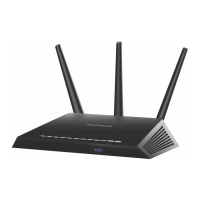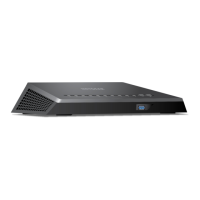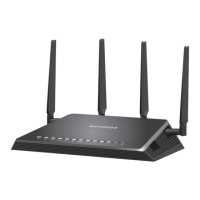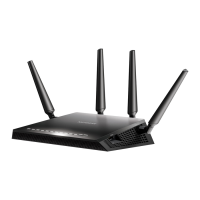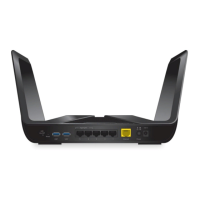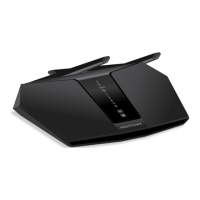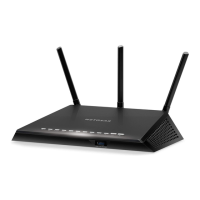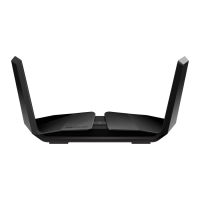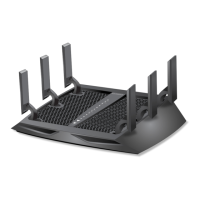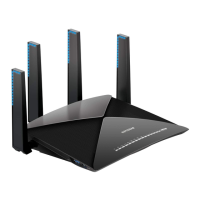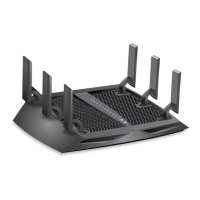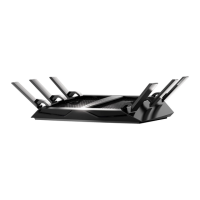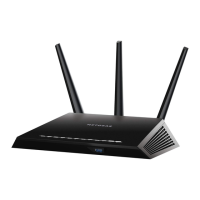
Do you have a question about the NETGEAR Nighthawk R7000P and is the answer not in the manual?
| DSL WAN | No |
|---|---|
| Ethernet WAN | Yes |
| 3G/4G USB modem compatibility | - |
| Wi-Fi band | Dual-band (2.4 GHz / 5 GHz) |
| Top Wi-Fi standard | Wi-Fi 5 (802.11ac) |
| WLAN data transfer rate (max) | 2225 Mbit/s |
| WLAN data transfer rate (first band) | 1625 Mbit/s |
| WLAN data transfer rate (second band) | 600 Mbit/s |
| Cabling technology | 10/100/1000Base-T(X) |
| Networking standards | IEEE 802.11a, IEEE 802.11ac, IEEE 802.11b, IEEE 802.11g, IEEE 802.11n |
| Ethernet LAN data rates | 10, 100, 1000 Mbit/s |
| Ethernet LAN interface type | Gigabit Ethernet |
| USB 2.0 ports quantity | 1 |
| Ethernet LAN (RJ-45) ports | 5 |
| Security algorithms | WEP, WPA, WPA2-PSK |
| Antennas quantity | 3 |
| Product type | Tabletop router |
| Product color | Black |
| LED indicators | Power |
| Processor cores | 2 |
| Processor frequency | 1000 MHz |
| Power source type | AC |
| Depth | 184.5 mm |
|---|---|
| Width | 285 mm |
| Height | 50 mm |
| Weight | 750 g |
Details on the contents of the Nighthawk AC2300 Smart WiFi Router package.
Instructions for attaching the three antennas to the router for optimal performance.
Explanation of the status and behavior of the router's LEDs.
Identification of connections and buttons on the router's rear panel.
Guidelines for optimal placement of the router for Wi-Fi signal range and performance.
Step-by-step instructions for connecting the router to a modem and power.
Methods for connecting devices to the router via wired or Wi-Fi.
Explanation of different login types for ISP, Wi-Fi, and router access.
How to access the router's settings and status via a web browser.
Using the NETGEAR genie app for network management and troubleshooting.
Guide to using the router's wizard for automatic Internet connection setup.
Manual configuration steps for various Internet connection types.
How to configure IPv6 connection types like Auto Detect, Auto Config, 6to4, etc.
Adjusting the Maximum Transmission Unit (MTU) size for network performance.
Configuring standard parental controls or Circle with Disney for content filtering.
Using access control rules to manage device connectivity to the network.
Blocking specific websites or domains using keywords.
Blocking specific network services or applications.
Configuring Wide Area Network (WAN) settings like port scan, DMZ, MTU, NAT filtering.
Configuring a default DMZ server to bypass firewall protection for specific applications.
Modifying the router's local IP address and subnet mask.
Assigning static IP addresses to specific devices on the LAN.
Configuring fundamental Wi-Fi settings like SSID, security, and channel.
Modifying the Wi-Fi network password and security protocol.
Creating a separate Wi-Fi network for guests.
Configuring the router to function as a Wi-Fi access point.
Using Dynamic QoS for better bandwidth allocation and traffic prioritization.
Enabling UPnP for easier device discovery and network connection.
Prioritizing Wi-Fi traffic for voice and video using WMM QoS.
Allowing the router to automatically select the best Wi-Fi band for devices.
Checking for and installing new firmware updates for the router.
Changing the router's admin password and setting up recovery options.
Verifying the router's current connection status to the Internet.
Accessing and managing the router's activity logs.
Enabling and configuring remote access to the router's settings.
Steps for physically connecting a USB storage device to the router.
How to access USB storage from a Windows computer.
How to access USB storage from a Mac computer.
Using ReadySHARE Vault for automatic backups of Windows computers.
Safely disconnecting a USB storage device from the router.
Configuring Dynamic DNS to access the network remotely using a domain name.
Enabling FTP access to the router's USB storage over the Internet.
Accessing USB storage remotely via the Internet.
Using ReadyCLOUD for remote access to USB storage files.
Configuring the router as a DLNA media server for media playback.
Playing music from USB storage via iTunes Server.
Accessing media files from USB storage on a TiVo device.
Installing printer drivers and connecting the USB printer to the router.
Obtaining the ReadySHARE Printer utility software.
Installing the NETGEAR USB Control Center utility.
Using the USB Control Center to print documents.
Utilizing the scanning feature of a multifunction USB printer.
Establishing a virtual private network (VPN) connection for secure remote access.
Installing OpenVPN client software on various devices.
Establishing a VPN tunnel from a Windows computer to the router.
Using a VPN to access your home's Internet service remotely.
Configuring port forwarding rules to allow incoming traffic to local servers.
Configuring port triggering for dynamic port opening.
Diagnosing issues using the router's LED status indicators.
Steps to resolve login issues with the router interface.
Troubleshooting guide for no Internet access after router setup.
Diagnosing and resolving issues with Wi-Fi connection.
Using the ping utility to diagnose network connectivity issues.
Details on resetting the router to its original factory default settings.
Specifications and technical details of the router hardware.
